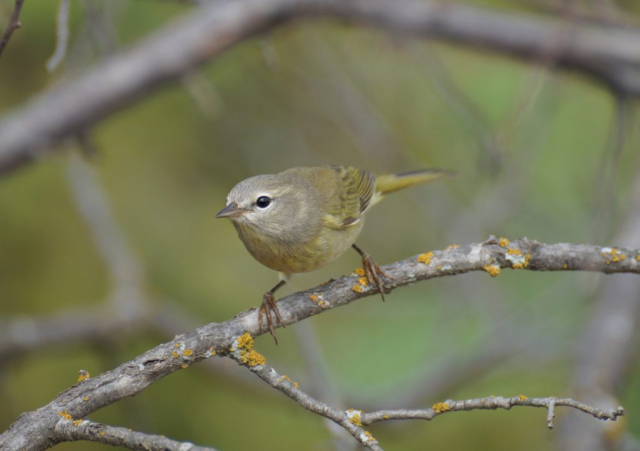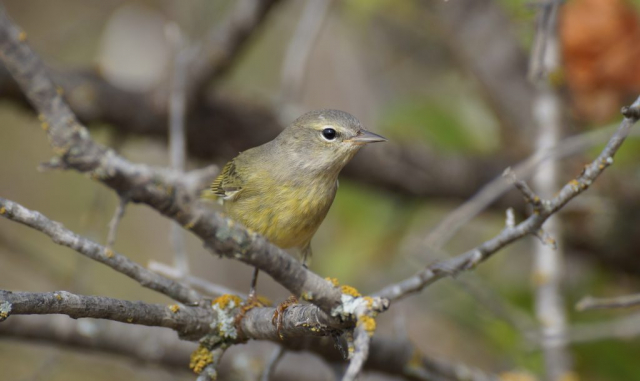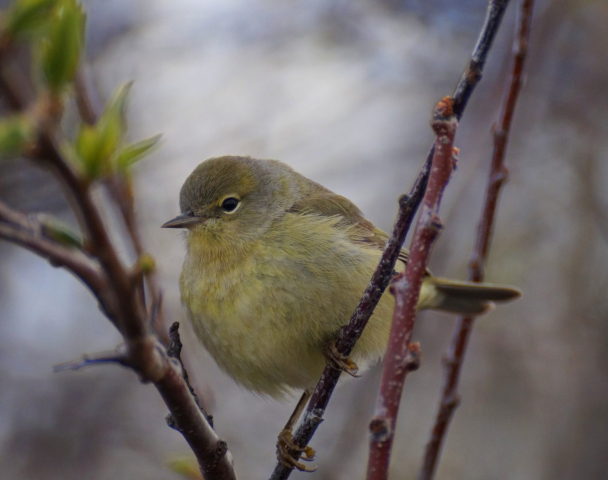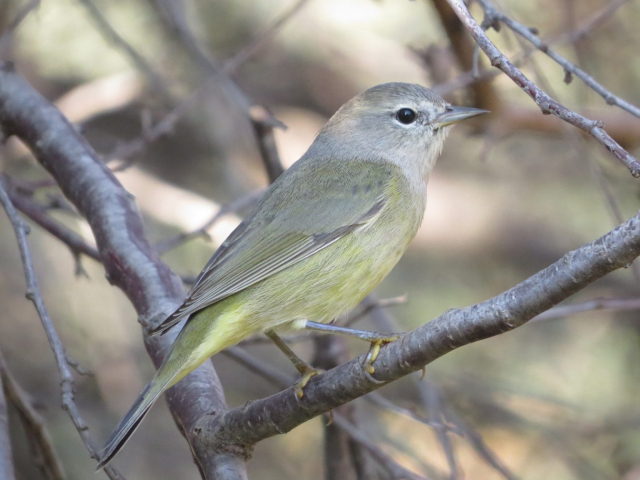Leiothlypis celata celata, O. c. orestera
Status: Common regular spring and fall migrant statewide. Rare casual winter visitor southeast.
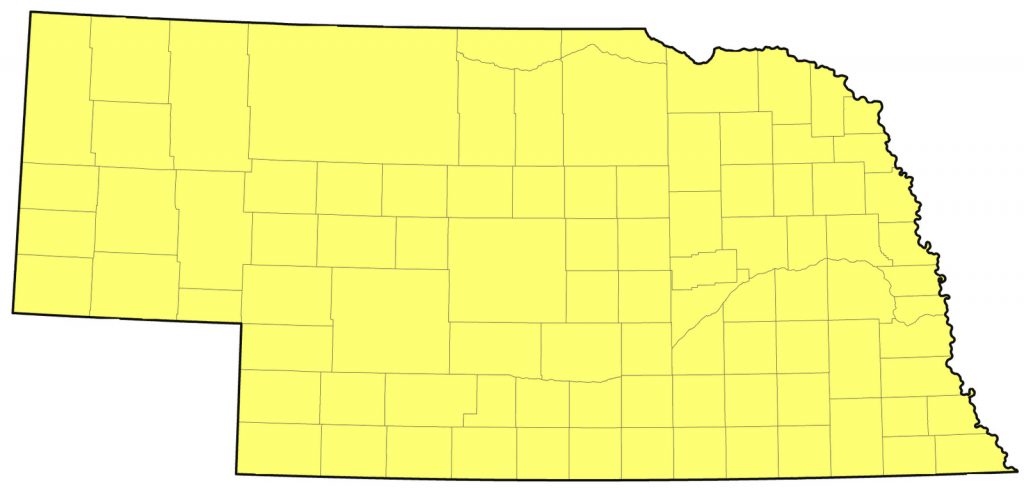
Documentation: Specimen: celata, UNSM ZM6809, 5 May 1898 Beatrice, Gage Co; orestera, UNSM ZM11930, 13 Sep 1911 Dawes Co.
Taxonomy: Four subspecies are recognized (AviList 2025): lutescens, breeding and wintering coastal southeast Alaska to southern California, sordida, resident California Channel Islands, orestera, breeding in Rocky Mountains to southwest USA and west Texas, and celata, breeding from Alaska across southern Canada, wintering coastal southern California to South Carolina and Florida.
Dunn and Garrett (1997) stated that orestera occurs in the Nebraska Panhandle in fall; it breeds as close as the Laramie Mountains in Wyoming (Faulkner 2010). Eastern celata occurs statewide, including the Panhandle. Subspecies orestera resembles Nashville Warbler without eye rings; many fall migrants in the Panhandle are brightly colored, especially yellowish underneath, and have gray crowns and napes which contrast with the greenish olive back. As stated by Josh Lefever of an orestera banded at Chadron SP: “Larger size and brighter yellow than the celata types usually captured”.
Documented records of orestera for Nebraska are from banding stations operated by Bird Conservancy of the Rockies and three specimens in UNSM collected in Dawes Co in fall 1911; the records are from 4 Sep-13 Oct. Nine orestera were banded at Chadron SP, Dawes Co 17-24 Sep 2015 and two on 4-13 Oct 2016, and at Wildcat Hills NC, Scotts Bluff Co 4 Sep and 8 Oct 2015, with a sighting 10 Oct 2015. Peak tallies in 2015 at Chadron SP were six celata and five orestera banded 22 Sep 2015. In 2022 at Chadron SP, Dawes Co six orestera and six celata were banded, orestera 6 Sep-8 Oct and celata 27 Sep-8 Oct. The three UNSM specimens are ZM11930 (cited above), ZM 12005 collected 15 Sep 1911, and ZM12006 collected 17 Sep 1911.
Although lutescens has not been documented in Nebraska, it breeds in the same general area as Cassin’s Vireo and Townsend’s Warbler, both of which are regular fall migrants through the western Panhandle in fall. Three Nebraska reports suggest lutescens. An overall bright yellow-green bird with no pale areas on its underparts and an exquisite lemon-yellow eye ring was at Oliver Reservoir, Kimball Co 20 Sep 2002 (Silcock, personal observation). A very yellow bird with yellow eye arcs was at Wilderness Park, Lancaster Co 11 Oct 2017. Two “very yellow” birds in Clay Co Sep 2000 (Jorgensen 2012) were thought to be orestera, but may have been lutescens.
There are 28 reports of lutescens in the northeast corner of Colorado in the period 17 Sep-15 Oct, and one for 23 Nov, and one in Kansas 24 Mar, but none in Oklahoma or South Dakota (eBird.org, accessed Jan 2024).
The type locality of O. c. celata is Omaha, Nebraska; it was collected by Thomas Say on the Long Expedition in 1819-1820 (AOU 1957, Sharpe et al 2001).
Spring: Apr 8, 9, 9 <<<>>> May 29, 30, Jun 1
Earlier dates are 1 Apr 2012 Douglas Co, and 2 Apr (specimen, UNSM ZM12004).
Later dates are 3 Jun (Tout 1947), and 12 Jun 2010 Garden Co.
Migrants arrive fairly early, in mid- to late Apr, and most depart by late May. In the northwest, Rosche (1982) considered it an uncommon to fairly common migrant.
The Rocky Mountains subspecies orestera, fairly common in fall in the Panhandle, has been reported only once in spring, at Oliver Reservoir, Kimball Co 28 May 2011. There are 10 spring records of orestera in eastern Colorado 27 Apr-17 May but none in Kansas; oddly, there are two Oklahoma records, 28 Mar and 13 Apr (eBird.org, accessed Jan 2024).
- High counts: 100+ in the eastern Rainwater Basin 3 May 2001, 85 at Gering Cemetery, Scotts Bluff Co 1 May 2016, and 72 at Twin Lakes WMA, Seward Co 28 Apr 2019.
Fall: Sep 3, 4, 4 <<<>>> Nov 5. 5, 7 (east and central), Aug 25, 25, 25 <<<>>> Oct 17, 17, 17 (west)
Earlier documented dates in the west are 17 Aug 2024 Oliver Reservoir, Kimball Co, 18 Aug 2019 Oliver Reservoir SRA, 17-19 Aug 2024 Oliver Reservoir, Kimball Co, 19 Aug 2021 Oliver Reservoir, and 19 Aug 2024 Oliver Reservoir.
A later date in the west is of two in Scotts Bluff Co 23 Oct 2024.
Early dates in the west are earlier than in the east; most such early migrants are probably the western subspecies orestera. According to Gilbert et al (2020), orestera is an earlier fall migrant than celata, although there is considerable variation in timing. There are several reports of orestera from Bird Conservancy of the Rockies banding stations in Dawes Co from 4 Sep-13 Oct, as well as elsewhere in the west.
This species is one of the last warblers to leave in fall. Later dates are generally eastern, with none in the west for Nov, suggesting celata is more cold tolerant than orestera.
There are at least 75 reports in the east in late Aug-early Sep that are undocumented and almost certainly mis-identified Tennessee Warblers (Gilbert et al 2020). The earliest documented record in the east is of one photographed in Knox Co 9 Sep 2020, and there are Nebraska specimens taken in 1911 on 13, 15, and 17 Sep (Global Biodiversity Information Facility https://doi.org/10.15468/dl.h6bq63). Gilbert et al (2020) cite data showing celata arrives in the US in Sep, and migration is “strikingly late”.
Later dates are 10 Nov 2021 Lancaster Co, 12 Nov 2023 Douglas Co, 20 Nov 2019 Forest Lawn Cemetery, Douglas Co, 22 Nov 2018 Douglas Co, 25 Nov 2017 Sarpy Co, 2 Dec 2022 Douglas Co, 5-17 Dec 2020 Sarpy Co, 9 Dec 2017 Lancaster Co, 1-2 at Stolley Park, Hall Co 11-15 Dec 2019, 12 Dec 2019 Republican City, Harlan Co, 17 Dec 2002 Omaha, Douglas Co, 18 Dec 1998 Harlan Co Reservoir CBC, 18 Dec 1999 Lincoln CBC, 21 Dec 1957 Scottsbluff CBC, 21 Dec 1996 Lincoln CBC, 21 Dec 2019 Schramm SP, Sarpy Co, and 26 Dec 2024 Hall Co. For Jan-Feb dates see Winter.
- High counts: 50+ in Thomas Co 30 Sep 2001, 50+ at North Platte, Lincoln Co 4 Oct 2010, 45 at Arbor Day Farm, Otoe Co 26 Sep 2000, 42 in the eastern Rainwater Basin 27 Sep 1999, and 31 at Oliver Reservoir, Kimball Co 8 Sep 2023.
Winter: The first documented Jan-Feb record for Nebraska was of one photographed at Conestoga Lake, Lancaster Co 27-28 Feb 2016; whether it wintered in the vicinity or was a very early migrant is conjectural. One first noted at a Lincoln, Lancaster Co feeder 9 Dec 2017 was found dead 1 Jan 2018, one was at Kearney, Buffalo Co 2 Jan 2025, and another was at Branched Oak Lake 26 Jan 2020. An additional four records were in winter 2020-2021: singles in Sarpy Co 5 Dec-31 Jan, in Douglas Co 7 Jan-1 Feb, at a different Douglas Co location 27-30 Jan, and in Lincoln, Lancaster Co 22 Jan-4 Feb 2021.
Orange-crowned Warbler normally winters north only to Oklahoma and Arkansas, although there are numerous Jan-Feb records in eastern Kansas and seven for Nebraska (see above; eBird.org, accessed Jan 2024).
Images
Abbreviations
CBC: Christmas Bird Count
NC: Nature Center
SP: State Park
SRA: State Recreation Area
UNSM: University of Nebraska State Museum
WMA: Wildlife Management Area (State)
Literature Cited
American Ornithologists’ Union [AOU]. 1957. The AOU Check-list of North American birds, 5th ed. Port City Press, Baltimore, Maryland, USA.
AviList Core Team, 2025. AviList: The Global Avian Checklist, v2025. https://doi.org/10.2173/avilist.v2025.
Dunn, J.L., and K.L. Garrett. 1997. A field guide to warblers of North America. Houghton Mifflin Company, Boston, Massachusetts, USA.
Faulkner, D.W. 2010. Birds of Wyoming. Roberts and Company, Greenwood Village, Colorado, USA.
Gilbert, W.M., M.K. Sogge, and C. van Riper. 2020. Orange-crowned Warbler (Leiothlypis celata), version 1.0. In Birds of the World (P. G. Rodewald, Editor). Cornell Lab of Ornithology, Ithaca, NY, USA. https://doi.org/10.2173/bow.orcwar.01
Jorgensen, J.G. 2012. Birds of the Rainwater Basin, Nebraska. Nebraska Game and Parks Commission, Lincoln, Nebraska, USA.
Rosche, R.C. 1982. Birds of northwestern Nebraska and southwestern South Dakota, an annotated checklist. Cottonwood Press, Crawford, Nebraska, USA.
Sharpe, R.S., W.R. Silcock, and J.G. Jorgensen. 2001. The Birds of Nebraska: Their Distribution and Temporal Occurrence. University of Nebraska Press, Lincoln, Nebraska, USA.
Tout, W. 1947. Lincoln County birds. Published by the author, North Platte, Nebraska, USA.Williams, F. 1980. Southern Great Plains Region. American Birds 34: 286-288.
Recommended Citation
Silcock, W.R., and J.G. Jorgensen. 2025. Orange-crowned Warbler (Oreothlypis celata). In Birds of Nebraska — Online. www.BirdsofNebraska.org
Birds of Nebraska – Online
Updated 23 Jul 2025
